6/15/2010
Will She Buy It?
Chris Beytes, Ellen C. Wells and Jennifer Zurko
I’m not quite sure what Chris Beytes was ranting about in
GrowerTalks. Something about (the now aptly named) Spring Trials being a grower event.
Grower event? If I remember correctly, Beytes is the one who’s always preaching, “You don’t make money growing plants, you make money selling plants.” And selling plants is what you’re all about. Am I right, retailers? After all, breeders can introduce as many plants as they’d like, and growers can grow each and every one of them if they so choose. But it’s you who are offering them up to home gardeners. And if you can’t sell the latest widget to come on the market, then it’s all for naught.
This is exactly why the word “Pack” has finally packed its bag and left the event title. It’s not about pack performance anymore. The percentage of sales attributed to six-packs is going the way of the eight-track. Growers—and distributors and academics and the press and yes, retailers—come to the annual spring unveiling of intros to kick the tires of their retail potential with this one question in mind: Will she buy it?
Sure, we all care about how well a plant grows, but that growing is done more and more in 4-in. or 6-in. pots, baskets or containers, and sometimes even coupled with non-related woody ornamental or tropical. And let’s not lose sight of the fact that what growers do—grow—and how they do it, has a direct impact on how much you pay for it and the size of your margins at retail. So, along with determining appeal on the retail bench, potential in the garden or on the patio, and supporting POP materials, Spring Trials attendees are ascertaining whether these new varieties can be grown with lower input costs—and brought to you for a price that’ll ensure you make money at the end of the day.
Maybe it is a grower event, after all, with your customer and your bottom line in mind.
Our Spring Trials coverage spans the gap between
Green Profit and
GrowerTalks. It’s Part 1 of our coverage, with Part 2 following in our August issues.
Ideal for Indies
Not everything is suitable for big boxes. Either it’s too large, too hard to bench-run or doesn’t appeal to a big- box type of shopper. That’s where IGCs step up and step in, to grow and sell some of the more persnickety or unfamiliar items (although any retailer skilled and daring enough can handle them). Want to set yourself apart with some bankable plants? Here’s a few we spotted.
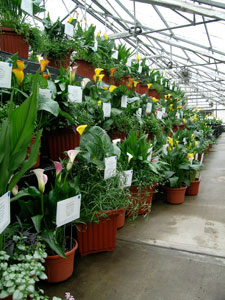
Golden State planted up a bunch of calla combination planters to show how you can add value to combos by adding premium callas … and vice versa. Perfect for grab-and-go patio décor.
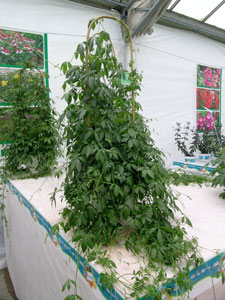
Gynostemma pentaphyllum from Hishtil. Also known as jiaogulan, this Zone 8 herbaceous vine is in the curcurbit family. It’s an age-old Chinese herbal remedy, and purported an anti-oxidant, but it also makes a lovely potted vine.
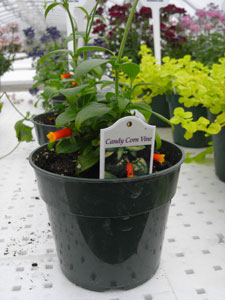
Candy corn vine (Manettia bicolor). This fun plant is perfect for autumn impulse sales—especially Halloween. PSI is one of the few propagators out there offering it commercially.
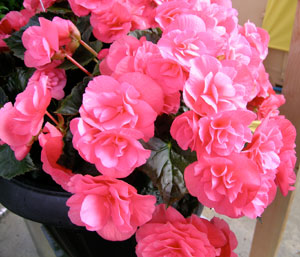
Dragone Pink Hope from Dümmen. With lovely, large flowers and the high number of blooms, this begonia is a sure sale. And with a name like Pink Hope, it’s an ideal item for in-house breast cancer awareness fundraisers.
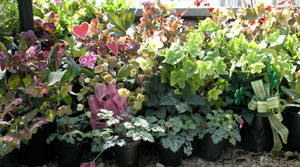
The Hellebore Gold Collection from Skagit Gardens. While not new this year, this collection of
niger- and
orientalis-type hellebores is still new enough to warrant some attention, especially from IGCs. These are hellebores that bloom between November and spring, and are meant for pot plants sales during the winter months. Display with poinsettias at Christmas or cyclamen during January and February. This past winter season, Skagit reports that some retailers re-ordered up to five times—and that’s during a time when shops really need the sales. (Pictured with dicentra Burning Hearts in the foreground.)

Alternanthera Little Ruby from GroLink. This item adds the trendy and much needed burgundy color to garden beds and patios. At just 12 in. tall and with short internodes, it packs a colorful punch in a small package.
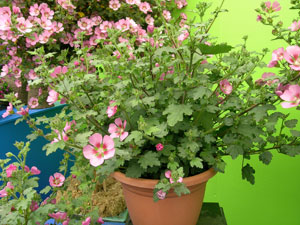
Anisodontea Slightly Strawberry from Proven Winners. This large-flowered cape mallow is a shrubby 2- to 3-ft. tall. It produces luscious pink flowers all summer long and adds color and structure to both borders and large containers. It blooms best with cool nights.
Edibles for the Picking
Vegetables, fruits and herbs weren’t just a fad in 2009. They’ve continued to be sure sellers for retailers this year, as well. Here’s a taste of what’s new in the edibles category for next year.
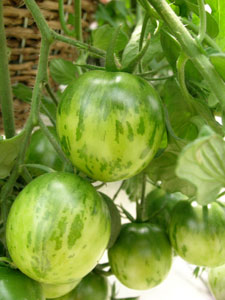 Tomatoes are still hot, and Floranova’s Vegetalis patio edibles division, offers up a bunch this year:
Tomatoes are still hot, and Floranova’s Vegetalis patio edibles division, offers up a bunch this year:
In Peardrops, F
1 hybrid vigor meets the appeal of an heirloom variety. You get unusual colors, great taste, disease resistance and high yield all contained in these small, plum-shaped, slightly striped yellow fruits on a compact plant. Rumor has it that tomatoes with green striping are a bit more acidic, balancing out the tomato’s flavor profile.
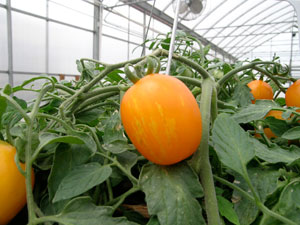
Speaking of stripes, Tumbling Tiger—a high-yielding variety with a neat trailing habit—joins the Tumbling series, and Rambling Red Stripe and Rambling Gold Stripe offer the small, egg- and pear-shaped striped fruits on plants with a more vigorous trailing habit.
For a video of this variety, click
HERE.
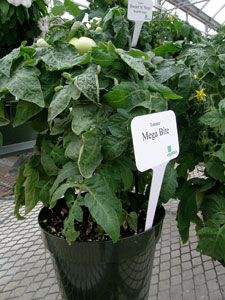
For a bit more “beef,” Mega Bite produces an abundance of Beefsteak-like fruits on sturdy, compact plants. All of these varieties are ideal for patio containers and/or baskets, and benefit from being sold as finished plants with some fruit beginning to set.
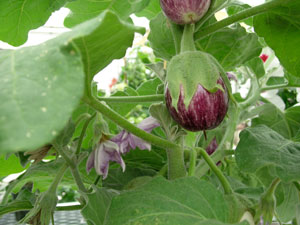
Stripes aren’t just for tomatoes. Vegetalis also introduced a striped eggplant (or aubergine, as the Brits so charmingly call them), appropriately called Pinstripe. It produces 20 or more goose egg-sized white-striped purple fruits on a small plant with compact growth. Its large flowers are striking, too.
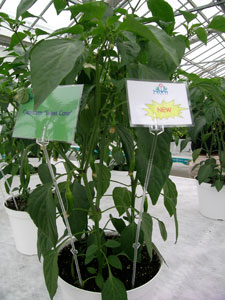
Peppers made a strong showing this year. From Hishtil, we saw two:
Sweet Cone (right) may look like a long hot pepper, but it’s as sweet as a bell pepper, with a high brix reading (sugar content). It gets the elongated shape from its semi “Italian” heritage. It also has a long life on the vine.
Don’t confuse Big Devil with Sweet Cone. As its name suggests, this pepper is both fiery and on the large side. The plants produce a high yield of juicy, meaty-fleshed peppers.
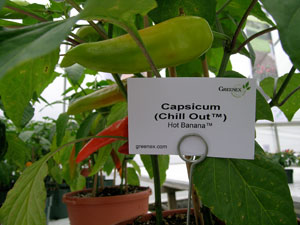
New in the Chill Out series from Ex Plant, a Greenex company, Hot Banana is a long pepper with a touch of heat. These plants produce a bountiful crop of fruits that turn from lime green to slick red. Hot Banana is ready for sale just 16 to 18 weeks after sowing.
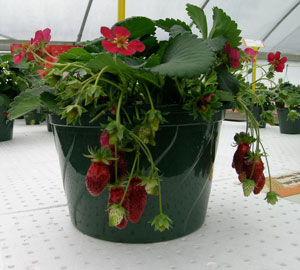
Fruits are just as popular as veggies these days, and although ABZ-Seeds’ strawberry varieties have been available in the U.S. market for some time, this was their first display at Spring Trials. All seven seed varieties positioned for the home gardener are daylength-neutral, meaning they’ll produce all season long. The different varieties have a range of flower color (white, pink, deep rose) habit (basket or bedding), and fruit size—some even have fragrant flowers! And good news for the grower—they come into flower directly from seed without depending on light or cold treatments. The variety in this photo is Tristan. For a video of this variety, click
HERE.
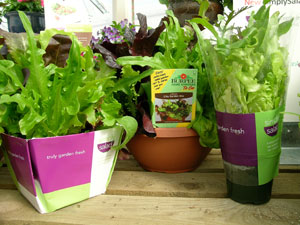
Salad Greens get their due with PanAmerican Seed’s SimplySalad. These are mixes of different cut-and-come-again salad greens, such as lettuces, arugula, radicchio and some greens with international flavors, available in four flavor profiles. SimplySalad is one of the new Fuseables multi-seed pellet mixes (read more about that on GTXX) and is part of the Burpee Home Gardens To Go program for next year. For videos of these programs, click
HERE and
HERE.
Taming the Tomaccio
Last year Hishtil introduced the Tomaccio Sweet Raisin tomato, the thick-skinned cherry tomato that dries into a tasty “raisin.” How does it dry exactly? We got the scoop so you can share it with your customers:
- Let the ripened fruit start shrinking on the vine, then harvest
- Place on a rimmed baking sheet and insert into a 100F oven
- Let dry for 3 to 4 hours
For a video explaining the process, click
HERE.
Hoops and Picotees and Stars, Oh My!
For some consumers, solid colors are just Plain Jane. They want a little pizzazz! Thank goodness for picotees, stars and hoops. This year’s crop of intros included a bunch of fun additions to this category.
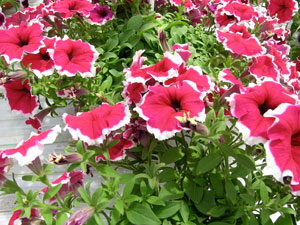
Pink Picotee joins the Burgundy and Purple Picotees in Fides’ Fortunia petunia series. They may eventually pair this down to just two picotees in the future, however. These picotees have the same compact, mounding habit, weather tolerance and long flowering periods you find in the other nine Fortunia varieties.
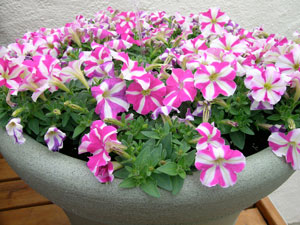
Syngenta’s Picobella Rose Star mini petunia has a naturally dwarf habit, so no PGRs are needed. With uniform and strong germination, it has a tight flowering window for bench-run sales. Good for use in borders, baskets and small containers.
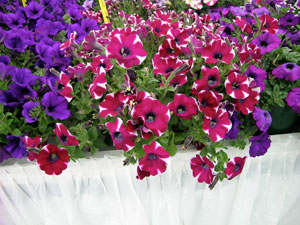
While not new for 2010, Danziger’s Cascadias Bicolor Cabernet certainly has an interesting story. This variety was selected as Bavaria’s 2009 Variety of the Year for all crops. Fruits, veggies, ornamentals—this one topped them all. As the winner, it was planted all over Bavaria and reportedly was seen spilling from the German state’s world-famous window boxes.
For a video of these varieties, click
HERE.
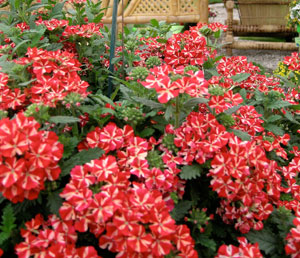
Estrella Voodoo Star from Westhoff is the rare verbena with a star pattern. Its large, orangey-red and white flowers are held close to the foliage and cover the plant entirely. With a semi-trailing habit and medium vigor, it’s an obvious basket and small container item.
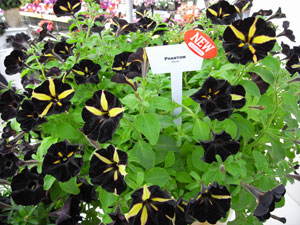
Not to be outdone by their solid-color sister Black Velvet, petunias Pinstripe and Phantom from Ball FloraPlant are just as velvety black and alluring. Pinstripe, however, has a thin purple-white star while Phantom has a fat yellow star.